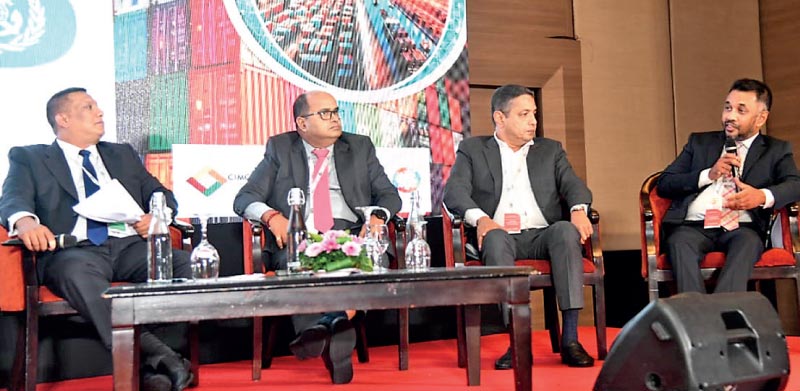Sunday Apr 20, 2025
Sunday Apr 20, 2025
Monday, 16 December 2024 02:51 - - {{hitsCtrl.values.hits}}

SLPA Managing Director Eng. Ganaka Hemachandra (right) expressing views at the discussion

SLPA Managing Director Eng. Ganaka Hemachandra (right) among the panellists at the discussion
|
SLPA Managing Director Eng. Ganaka Hemachandra
|
“A project and process are currently underway to utilise land owned by the Sri Lanka Ports Authority (SLPA) and the Port of Colombo (POC) for solar energy harvesting, aiming to produce green hydrogen under the port’s Green Energy Initiative program,” said SLPA Managing Director Eng. Ganaka Hemachandra.
He made these remarks as a panellist during a discussion on ‘Future Fuels, the Planet, and Shipping – Clean Energy Efficient Integrations and Green Robotics in Ports,’ at the Colombo International Maritime and Logistics Conference, held recently at the Cinnamon Grand, Colombo.
Speaking further, he noted that the port currently consumes 25% of the total energy usage in the city of Colombo, equivalent to nearly 50 MW. “It is crucial to discuss how we can implement effective measures to immediately address greenhouse gas emissions in all port-related activities, which is a pressing global concern. Currently, only about 42% of Sri Lanka’s total energy generation is from green sources, while the remainder comes from non-green sources. This is a serious issue that requires urgent attention and action,” he emphasised.
Eng. Hemachandra highlighted the need to encourage innovation and simultaneously adopt advanced technologies in the local port sector to produce green energy for future requirements and ensure the sector remains environmentally sustainable.
“The POC is also exploring the implementation of cutting-edge technologies to minimise both energy wastage and greenhouse gas emissions. While achieving this is no small feat due to the substantial investments required, we are committed to aligning with the global targets outlined in the IMO’s 2030–2050 program,” he added.
He also revealed that the East Container Terminal (ECT) at the POC, which will be the port’s first semi-automated terminal, is set to integrate clean energy into its operations. The terminal will also leverage green robotics and AI-based technologies for ship and yard planning. By 2025, the port will also be equipped to supply green shore power to vessels calling at its terminals.
“Several constraints in the past barred our capability to establish a fossil fuel refuelling centre. However, with emerging opportunities, we must consider how our port can evolve as a green energy refuelling centre as we transition from the present to the future. Optimum usage of energy is now a mandatory requirement,” he said.
The global call to reduce carbon emissions and other harmful gases has created a demand for new energy sources to power ships and ports effectively, thereby reducing the carbon footprint that impacts the planet’s health. This transition involves every stakeholder in the global supply chain, from consumers to manufacturers and intermediaries. The industry must adopt sustainable green energy solutions, advanced robotics, and new infrastructure to support global trade.
This discussion underscores key points for the ports and shipping sectors to remain relevant and competitive by providing environmentally friendly solutions. It also highlights the importance of attracting new investments, increasing business opportunities, and adopting best practices to ensure sustainability in terminal operations.
The conference, endorsed by the Ministry of Transport, Highways, Ports and Civil Aviation and the Ministry of Foreign Affairs, was organised by CIMC Events Ltd. It brought together local and international experts across various sectors in the maritime and logistics industries, as well as professionals and academics from both public and private sectors.
Discover Kapruka, the leading online shopping platform in Sri Lanka, where you can conveniently send Gifts and Flowers to your loved ones for any event including Valentine ’s Day. Explore a wide range of popular Shopping Categories on Kapruka, including Toys, Groceries, Electronics, Birthday Cakes, Fruits, Chocolates, Flower Bouquets, Clothing, Watches, Lingerie, Gift Sets and Jewellery. Also if you’re interested in selling with Kapruka, Partner Central by Kapruka is the best solution to start with. Moreover, through Kapruka Global Shop, you can also enjoy the convenience of purchasing products from renowned platforms like Amazon and eBay and have them delivered to Sri Lanka.
Discover Kapruka, the leading online shopping platform in Sri Lanka, where you can conveniently send Gifts and Flowers to your loved ones for any event including Valentine ’s Day. Explore a wide range of popular Shopping Categories on Kapruka, including Toys, Groceries, Electronics, Birthday Cakes, Fruits, Chocolates, Flower Bouquets, Clothing, Watches, Lingerie, Gift Sets and Jewellery. Also if you’re interested in selling with Kapruka, Partner Central by Kapruka is the best solution to start with. Moreover, through Kapruka Global Shop, you can also enjoy the convenience of purchasing products from renowned platforms like Amazon and eBay and have them delivered to Sri Lanka.